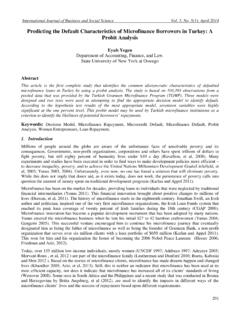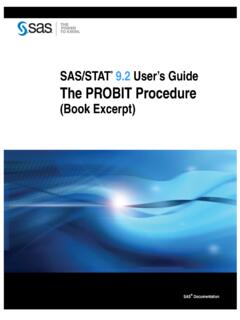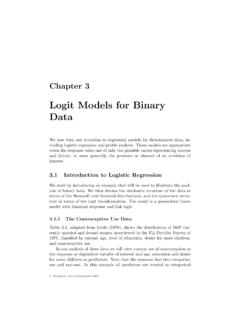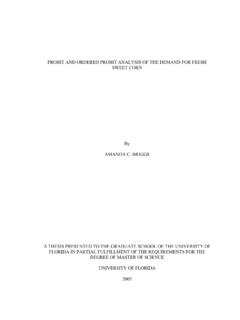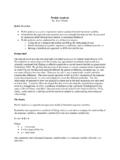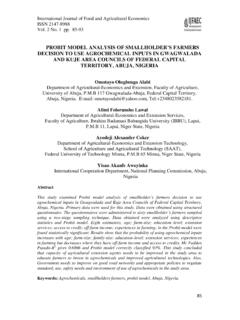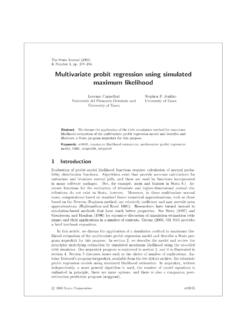Transcription of An ordered probit analysis of transaction stock prices*
1 Journal of Financial Economics 31 (1992) 319-379. North-Holland An ordered probit analysis of transaction stock prices* Jerry A. Hausman and Andrew W. Lo Massachusetts Institute qf Technolog_v, Cambridge, MA 02 139, USA A. Craig MacKinlay Ukersity of Pennsyhania, Philadelphia, PA 19104, USA Received January 1991, final version received March 1992 We estimate the conditional distribution of trade-to-trade price changes using ordered probit , a statis- tical model for discrete random variables. This approach recognizes that transaction price changes occur in discrete increments, typically eighths of a dollar, and occur art irregularly-spaced time intervals.
2 Unlike existing models of discrete transactions prices, ordered probit can quantify the effects of other economic variables like volume, past price changes, and the time between trades on price changes. Using 1988 transactions data for over 100 randomly chosen stocks , we estimate the ordered probit model via maximum likelihood and use the parameter estimates to measure several transaction -related quantities, such as the price impact of trades of a given size, the tendency towards price reversals from one transaction to the next, and the empirical significance of price discreteness. 1. Introduction Virtually all empirical investigations of the microstructure of securities mar- kets require a statistical model of asset prices that can capture the salient *We thank Arnout Eikeboom for excellent research assistance and many helpful comments, and Sarah Fisher, Ayman Hindy, and John Simpson for research assistance on earlier drafts of this paper.
3 We have also benefited from the comments of Bill Schwert (the editor), Bruce Lehmann (the referee), Rob Bliss, Larry Harris, Joel Hasbrouck, Bob Merton, Whitney Newey, Peter Rossi, Alex Samarov, Ken Singleton, and Ronald Thisted, as well as seminar participants at Boston College, the California Institute of Technology, Carnegie Mellon University, Cornell University, the Federal Reserve Bank of Cleveland, Harvard University, Indiana University, the 1991 Johnson Symposium at the University of Wisconsin Madison, the London Business School, MIT. the NBER Summer Institute, Northwestern University, the Q Group Spring 1992 Seminar, Rice University, Stanford University, Temple University.
4 The University of British Columbia, UC Berkeley, UCLA, the University of Chicago, the University of North Carolina, the University of Rochester, the University of Texas at Aus:: Vanderbilt University, and Washington University. Research support from the Batte:ymarch Fellowship, the Geewax-Terker Investments Research Fund, the MIT International Financial Services Research Center, the Nation 11 Science Foundation (SES-8618769, SES-8821583X and the Q Group is gratefully acknowledged. 0304-405X/92/$ c; 1992-Elsevier Science Publishers All rights reserved 320 Hausman et al., An ordered probit analysis ojtransaction stock prices features of price movements from one transaction to the next.)
5 For example, because there are several theories of why bid/ask spreads exist, a stochastic model for prices is a prerequisite to empirically decomposing observed spreads into components due to order-processing costs, adverse selection, and specialist market power. l The benefits and costs of particular aspects of a market s microstructure, such as margin requirements, the degree of competition faced by dealers, the frequency that orders are cleared, and intraday volatility also depend intimately on the particular specification of price Even the event study, a tool that does not explicitly assume any particular theory of the market microstructure, depends heavily on price dynamics [see, for example, Barclay and Litzenberger (1988)].
6 In fact, it is difficult to imagine an economi- cally relevant feature of transaction prices and the market microstructure that does not hinge on such price dynamics. Since stock prices are perhaps the most close!y watched economic variables to date, they have been modeled by many competing specifications, beginning with the simple random walk or Brownian motion. However, the majority of these specifications have been unable to capture at least three aspects of transaction prices. First, on most stock exchanges, prices are quoted in increments of eighths of a dollar, a feature not captured by stochastic processes with continu- ous state spaces.
7 Of course, discreteness is less problematic for coarser-sampled data, which may be well-approximated by a continuous-state process. But discreteness is of paramount importance for intraday price movements, since such finely-sampled price changes may take on only five or six distinct The second distinguishing feature of transaction prices is their timing, which is irregular and random. Therefore, such prices may be modeled by discrete-time processes only if we are prepared to ignore the information contained in waiting times between trades. Finally, although many studies have computed correlations between transac- tion price changes and other economic variables, to date none of the existing models of discrete transaction prices have been able to quantify such effects formally.
8 Such models have focused primarily on the unconditional distribution of price changes, whereas what is more often of economic interest is the conditional distribution, conditioned on quantities such as volume, time between trades, and the sequence of past price changes4 For example, one of the See, for example, Glosten and Harris (1988). Hasbrouck (1988), Roll (1984). and Stoll(l989). See Cohen et al. (1986). Harris, Sofianos, and Shapiro (1990), Hasbrouck (1991a, b), Madhavan and Smidt (1991), and Stall and Whaley (1990). 3 The implications of discreteness have been considered in many studies, , Cho and Frees (1988), Gottlieb and Kalay (1985), Harris (1989a.)
9 B, 1991), Petersen (1986), and Pritsker (1990). 4 There is however a substantial literature on price/volume relations in which discreteness is ignored because of ;he return horizons involved (usually daily or longer). See, for example, Campbell. Grossman, and Wang (1991) Gallant, Rossi, and Tauchen (1992), and Karpoff (1987). Hausman et al., An ordered probit analysis of transaction stock prices 321 unresolved empirical issues in this literature is what the total costs of immediate execution are, which many take to be a measure of market liquidity. Indeed, the largest component of these costs may be the price impact of large trades.
10 A floor broker seeking to unload 100,000 shares of stock will generally break up the sale into smaller blocks to minimize the price impact of the trades. How do we measure price impact? Such a question is a question about the conditional distribution of price changes, conditional upon a particular sequence of volume and price changes, , order flow. In this paper, we propose a specification of transaction price changes that addresses all three of these issues, and yet is still tractable enough to permit estimation via standard techniques. This specification is known as ordered probit , a technique used most frequently in cross-sectional studies of dependent variables that take on only a finite number of values possessing a natural For example, the dependent variable might be the level of education, as measured by three categories: less than high school, high school, and college education.



